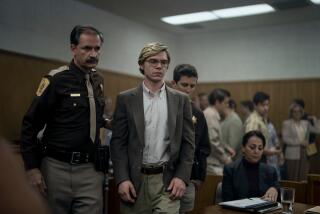Book Review: ‘Good Neighbors’
Good Neighbors
A Novel
Ryan David Jahn
Penguin: 280 pp., $15 paper
How fair is it to hold a novel to actual events? It’s a question I kept asking as I read Ryan David Jahn’s first book, “Good Neighbors” (published in England as “Acts of Violence” in 2009), based on the notorious murder of Kitty Genovese, the Queens, N.Y., bar manager stabbed to death early on the morning of March 13, 1964, outside her Kew Gardens building. Although the attack continued, with a break, for 30 minutes, only one of the people who witnessed it from their apartments — 38 of them, according to an iconic New York Times story that ran two weeks after the killing — did anything to help.
Over the years, the Genovese murder has become a touchstone, first as a symbol of urban apathy and later as an urban myth. Researchers have debunked the 38 witnesses account, suggesting that, of those who actually saw anything, perhaps as few as two had any real sense of what was going on. It was 3:15 a.m. on a cold night; people were sleeping, and windows were closed. There is even evidence that police were called during the attack, but the archaic reporting structures of the NYPD — there was no 911 in 1964 and callers had to give substantial information about themselves — hampered the response.
None of this factors into the plot of “Good Neighbors,” nor does it have to, since Jahn’s version is crime story as morality play. All the same, it can’t help but underlie our reaction to the novel, if only because of the book’s relationship to the case. The basic set-up is identical: On March 13, 1964, a 28-year-old bar manager, here named Katrina Marino, drives home through the early morning streets of Kew Gardens, parks where Genovese parked and comes upon her assailant almost instantly. The killer disappears in the middle of the attack, then returns to finish the job. There is a sexual assault. Authorities do finally arrive, only to have the victim die in the ambulance. For Jahn, however, this is less text than subtext — or, more accurately, context — a template against which his larger story can unfold.
That larger story has everything to do with the witnesses who hear Katrina’s cries and do not act. To highlight this, Jahn structures the book like a spinning top, one character leading to the next. After opening with the attack, he moves to a young man named Patrick, who has just awakened to care for his ailing mother, and then to the woman Patrick sees through her window across the courtyard as she weeps in a negligee. The idea is to evoke a kaleidoscopic sense of the apartment complex, to establish each of its residents as both individuals and part of a larger web. That’s an interesting approach, but it falls apart beneath the weight of its expectations, since each life comes invested with a crisis, a bit of narrative urgency, that serves to undermine the credibility of the novel as a whole.
For “Good Neighbors” to succeed, we must believe that on the same late night in the same apartment complex, nearly everyone is wrestling with issues of life and death. For Patrick, these include not just his mother’s health but his draft status, while others must face the breakdown of their marriages, or confront suicide, sexual identity, the fallout of wife swapping or the aftermath of childhood abuse. There are not one but two automobile accidents, a corrupt cop, an (unrelated) attempted murder and an ambulance attendant with an ax to grind. All this on a random night in Queens as a young woman is being murdered.
Because of their concerns, these characters are distracted. Or, at least, that’s the implication. “She’s just sitting there,” one character says after the first attack, as Katrina, wounded, gathers her strength in the complex courtyard. “She might be hurt. I think I see blood. Maybe we should call the police.” Another replies: “I’m sure someone already has. We shouldn’t tie up the lines.” This goes on for two hours, as the attacker returns home and gets into bed with his wife, before deciding he hasn’t had enough.
Here, we find the most troublesome aspect of “Good Neighbors”: that it defies narrative logic. It’s strange enough that the attack on Genovese stretched over half an hour, with the killer, Winston Moseley, retreating to his car after someone yelled from a window, “Let that girl alone!” Yet Moseley was just waiting out the witnesses, waiting for quiet to fall again. In Jahn’s telling, there is no quiet, just a nightscape as curiously active as the day. And in the midst of it, he asks us to believe, for two full hours in an apartment complex, an assault and murder takes place, with people awake and aware, watching, disengaged, until they see a courtyard full of blood.
How much more powerful would this novel be if all these witnesses had nothing going on except the moral darkness of apathy? How much more powerful if they didn’t care or didn’t want to get caught up in it, if it were a matter of the bleakness of their souls? That’s what made the Genovese case so powerful in the first place, and it’s what continues to draw us to it even now.
More to Read
Sign up for our Book Club newsletter
Get the latest news, events and more from the Los Angeles Times Book Club, and help us get L.A. reading and talking.
You may occasionally receive promotional content from the Los Angeles Times.







